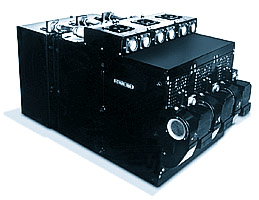Argon-11c Computer
Home → Articles → Argon Family of Computers → Argon-11c Computer
V. V. Chesnokov
- Argon-11С was a specialized mobile computer.
- The development team chiefs: G. M. Prokudaev, N. N. Solovyov.

Argon-11C Computer
The development team: Yu. S. Gorshenin, V. M. Anilov, L. I. Bochkarev, A. T. Eryemin, Yu. N. Maksakov, Yu. R. Lemzal, A. S. Salman, V. M. Ternovsky.
- Development organization: the Scientific Research Institute of Electronic Machines (NIEM)
- Manufacturer: NIEM pilot production.
- The development was completed in 1968.
- There was no full-scale production.
- Application: Zond space probe control system.
- 21 computers were manufactured during the pilot production period.
- The system architecture: single-address computer with parallel processing. The computer structure and architecture were specially developed to minimize the instruction set. The computer included three functionally independent computing units with separate inputs and outputs. The units were interconnected by channels used for information exchange and synchronization. Information was processed in real time. Information input-output was controlled by software.
Number representation - fixed point. Word length - 14 bits, command length - 17 bits. Number of instructions - 15.
Execution times: addition - 30 ms, multiplication - 160 ms.
RAM capacity - 128 14-bit words, ROM capacity - 4,096 17-bit words.
Number of register single-channel inputs for each channel - 25; calculating information inputs with capacity of 64 signals - 3; register single-channel outputs - 40.
Types of check - program and test.
- Components: hybrid ICs Tropa-1.
- Construction: the computer was constructed as two units combined into mono-block device. There were three-channel exchange and computing unit with three RAM modules and three-channel ROM unit. The printed circuit boards in all units were assembled in a book-like package and interconnected by "spine" made of hinged punched plates with flexible wires. Cooling was carried out by heat abstracting to the housing and by using built-in fans.
- Technology: unified double-sided printed circuit boards.
- Software: a set of standard programs, working programs, test check programs for prototypes testing.
- Specifications:
Operating temperatures - from 0 to 40°С.
Ambient pressure - from 400 to 1,000 mm Hg.
Vibration - up to 10 g (from 1 to 2,500 Hz).
Power consumption - 75 W.
Dimensions - 305 x 305 x 550 mm.
Weight - 34 kg.
Time of continuous work - 2 h 40 min.
Reliability - the probability of no-failure operation in two channels during 8 days was 0,999.
15. Special features: the first mobile computer with hardware triple redundancy, installed in the space vehicle that orbited the Moon and returned to Earth (Zond program).



